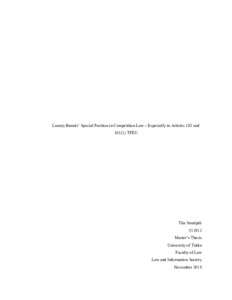Luxury Brands’ Special Position in Competition Law – Especially in Articles 102 and 101(1) TFEU
Suuripää, Tiia (2018-11-07)
Luxury Brands’ Special Position in Competition Law – Especially in Articles 102 and 101(1) TFEU
Suuripää, Tiia
(07.11.2018)
Julkaisu on tekijänoikeussäännösten alainen. Teosta voi lukea ja tulostaa henkilökohtaista käyttöä varten. Käyttö kaupallisiin tarkoituksiin on kielletty.
avoin
Julkaisun pysyvä osoite on:
https://urn.fi/URN:NBN:fi-fe2018112949537
https://urn.fi/URN:NBN:fi-fe2018112949537
Tiivistelmä
The thesis evaluates luxury brands’ special position in competition law. The two areas I focus on are excessive pricing and selective distribution, which are both prohibited under the Treaty on the Functioning of the European Union. In order to evaluate luxury brands position, the interface between brands and trademarks is evaluated. The method used is legal dogmatic as the thesis evaluates current and applicable legislation as well as case law.
Regarding luxury brands, trademarks are a relevant part of the luxury brand as these have often held equivalent. Trademark holder is not automatically held to have a dominant position although in theory the exclusive right granted may seem applicable under Article 102 TFEU. Excessive prices may be justified, as consumers are willing to pay a high price of luxury products as the high price may indicate superior quality and good reputation. Thus, a trademark may have better protection in the light of luxury branded products but trademark is still not justifying abuse of a dominant position.
ECJ’s conclusion in case C-230/16 Coty Germany v Parfümerie Akzente indicates that selective distribution is treated differently in the light of luxury brands. The prestige image and aura of luxury are preserved. Thus, luxury brands have extensive protection. Similarly, ECJ’s conclusion clarified legal uncertainty. However, the definition of luxury products is still left open.
Regarding luxury brands, trademarks are a relevant part of the luxury brand as these have often held equivalent. Trademark holder is not automatically held to have a dominant position although in theory the exclusive right granted may seem applicable under Article 102 TFEU. Excessive prices may be justified, as consumers are willing to pay a high price of luxury products as the high price may indicate superior quality and good reputation. Thus, a trademark may have better protection in the light of luxury branded products but trademark is still not justifying abuse of a dominant position.
ECJ’s conclusion in case C-230/16 Coty Germany v Parfümerie Akzente indicates that selective distribution is treated differently in the light of luxury brands. The prestige image and aura of luxury are preserved. Thus, luxury brands have extensive protection. Similarly, ECJ’s conclusion clarified legal uncertainty. However, the definition of luxury products is still left open.
